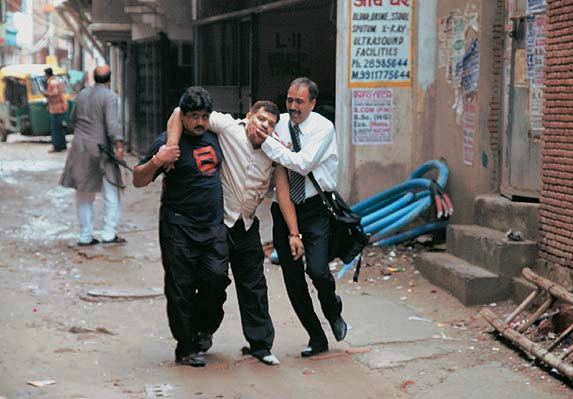Afroz Alam Sahil and Kamala Kanta Dash
New Delhi: After three years of the infamous ‘encounter’ at Batla House, the details on how Inspector Mohan Chand Sharma was killed is still sketchy. Post-mortem report availed from NHRC through RTI does not reveal much though raise enough curious points towards the inconsistency in police version. In all such cases as per the NHRC guidelines videography of the postmortem is carried out and the CD along with the pictures of the affected regions of the body of the victim is sent to the commission. It is not clear whether this was done in this case as only the photographs have been sent to the NHRC.
One of the interesting but untenable justification on why MC Sharma did not wear the bullet proof jacket has been the ability of the jacket to attract public attention with a potential to disrupt the police plan of action (POA).
Another aspect that has been ignored in the analysis is the loss of around 2.5 to 3.00ltrs of blood before Mr. Sharma died. This has not been explained whether this huge amount of blood was lost on the way from Batla House to Holy Family Hospital or during the time he was there till he was declared dead at 7.00pm local time. Photograph of Mr. Sharma being taken by his colleagues to the hospital does not show whether he was bleeding profusely. Mr. Sharma’s white shirt does not show any blood stains when he was on the street after being brought down from the fourth floor of L-18 where he was allegedly shot by Atif and Sajid.
We reproduce in the following table the RTI response on whether the firearm wounds received by Inspector Mohan Chand Sharma can be caused by accidental firing of a colleague police officer of raiding party at the time of incident.
As per the postmortem report of deceased Mr. Sharma, there were two entry points:
Both the entry wounds were located on the front side of the body of deceased MC Sharma. The direction of firearm wounds were as under
In view of the above findings, considering the circumstances of event as explained by Inspector Rahul Kumar and animated reconstruction of sequence of events, the board members are of the considered opinion that such firearms are unlikely to be caused by accidental firing of a colleague police officer of raiding party in the given circumstances. Note: This was the response of the post-mortem team led by Central Forensic Science Laboratory (CFSL) and AIIMS. The letter was forwarded to Shri Bhairon Singh Gurjar of Delhi Police by Dr. TD Dogra, Professor at AIIMS.
|
BeyondHeadlines applied RTI to Jai Praskh Narayan Apex Trauma Centre of AIIMS to access information on the postmortem reports of Atif, Saijd and MC Sharma. In the response to this RTI, AIIMS chose to invoke the Section 8 (g) and (h) of RTI Act 2005 to withheld information. Section 8 (g) refers to the information that can cause harm to someone’s life and 8 (h) refers to the information that can impede in the process of an ongoing investigation. Conveniently this was not explained how the postmortem reports of Atif, Sajid and MC Sharma could have harmed anyone else. Moreover, it was also not clear how the postmortem reports could have interfered in the process of police investigation.






















